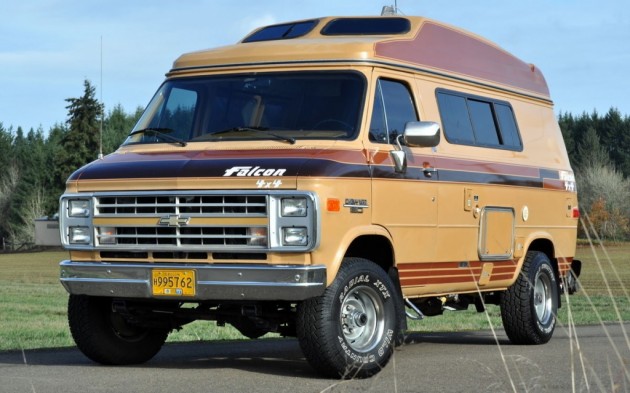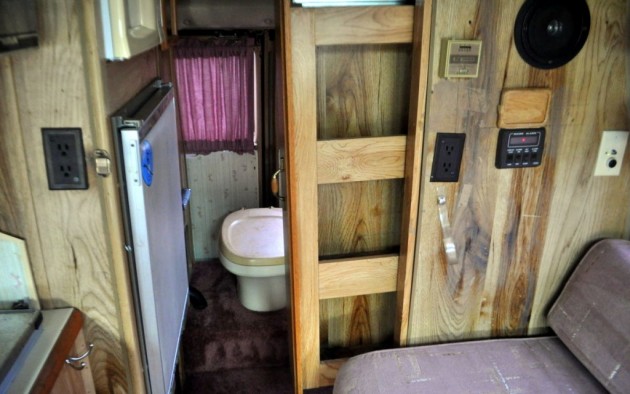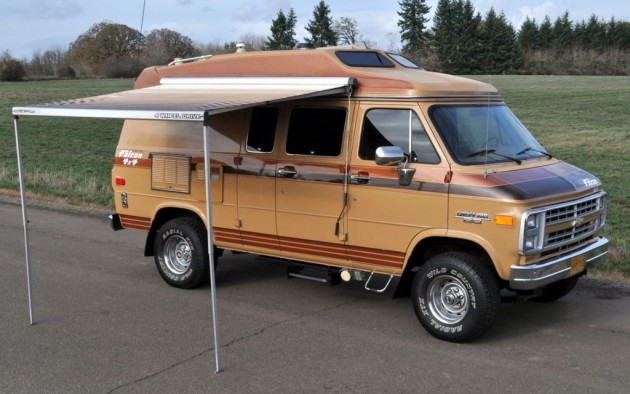This camper van is awesome. Not only does it have a toilet and shower, but it’s four wheel drive so it should be able to go just about anywhere! It appears to be in amazing condition and the seller includes a book length description here on eBay. It’s located in Salem, Oregon and the bidding has already taken off with about a week left. Most campers this old are too crusty to even think about sleeping in, but this one looks like it is ready to play!
The front seats swivel around into an airy kitchen/dining area. There’s a stove, sink, and even a microwave. I’m guessing the seating turns into a bed at night. The color scheme may not be the best, but there appears to be lots of storage. These conversions were done by a company called Falcon, hence the model name.
Here’s a shot of the bathroom. Things look a little tight back there, but I bet you can reach the fridge from just about anywhere…
There’s even an awning on the side of the van in case things get a little cramped inside. This looks like a great usable classic. It’s not something you would want to drive around everyday, but back country camping trips would be great fun in a rig like this!






Wow, that was a thorough description. Nice vehicle.
This looks like a very nice van camper! For the person looking for such an RV this unit should provide many years of enjoyment. Back in the day I worked for a chain of RV dealerships and we sold a few of these over the years. Many of them were two wheel drive, however the 4×4 conversion was a desirable option. The only problem with the Chevy van is it is basically a unitized body, and they will develop stress cracks if taken off road much. For that occasional soft spot or for snow and ice they are ideal.
If you are over four feet tall the shower is too small. The tub is good for washing off the kids after a day at the beach, but that it about the limits of it. The G-20 is actually a bit weak for the weight of a van camper. Chevy vans in those days were rated one level lower than the pick up trucks. A G-10 was a very lightweight van not capable of hauling much weight, so you never see one converted to a custom van or a van camper. The G-20 shared the running gear with the C-10. The G-30 shared its running gear with the C-20. We had problems with all van campers built in G-20 vans. The tires were B rated and the weight of a van camper overloaded them. Tire failures were common. Upgrading to a load range C tires fixed the tire problem. The rear springs would sag, sometimes leaning to one side due to uneven loading. Overloads or Firestone Ride-Rite supplemental air springs fixed that problem.
Overall these rigs were solid and enjoyable, however a few owners were soured with the problems that did occur. Of course the best bet was to spec out your van camper in G-30 van. Then you got a full floating axle, lower gear ratio, HD springs with progressive overloads, eight lug wheels, load range D tires, bigger brakes, HD suspension, and an upgraded cooling system. .
Charles, it’s my understanding that Chevy vans use a similar designation system as their trucks. I have had a few ranging from the half ton G-10 to the dually, diesel G-30…the half ton truck is a c-10, van a g-10. 3/4 ton is c-20 or g-20 and the one ton is ton is the c-30 or g-30. If a c-10 truck has a half ton rating what rating would a g-10 van have?
Charles is correct about the light way that the vans were built back in those days. I had a ’94 G-20 Gladiator conversion, and it certainly was not in the same league as a similar vintage C-20 pickup. Lighter running gear and everything else. It had an annoying issue with going through rear axle bearings, just not HD enough.
I heard a mechanic refer to it as a “5/8 ton” unit once… Techs certainly could tell the difference. Performed like a half-ton unit as far as I was concerned.
And of course this unit would be far more desirable had it been built on the G-30 chassis.
The G-10? I’d call that a “3/8 ton” van!
If there is any question regarding my opinion of this van here on BF though, know that I really like it. It stands as a time-warp, and is in seemingly great condition. For one or two people to do some light off-the-path adventuring, it would seem to be a desirable option.
Mountain Man, the G-10 is considered a 1/2 ton by GM and the G-20 is considered a 3/4 ton, however look at the wheel lug pattern on a G-20 compared to a C-20 and you will instantly see the difference. The running gear on a G-10 is similar to a base C-10, and the running gear on a G-20 is similar to the running gear on what they used to call a “Heavy Half” C-10. The GVW rating is also similar. Most G-30’s have a full floating rear axle, and all of the G-30’s have 8 lug wheels.
This would be a nice camper for just me and the wife, I really like the idea of the 4 wheel drive and that awning adds a nice touch.
What a great old van. RV’s are nice for travel (my opinion) and this one has a lot going for it. I currently have a 29′ class C (van cab in front) that the wife and I have been traveling in for almost a year. The advantage of this van is the size. Its easy to boondock in a van since you fit in a single parking spot. The 4×4 is a big plus also. We are looking for a larger RV for the long trips like we are on now but I would love a van like this for weekend trips, road trips etc.
This one pegs the meter on period ugly. Best example I have seen and I have been looking at a few. Amazing what good condition most of them are that I find.
While this looks to be in great shape, you better pull a gas tanker behind you. Standard vans got atrocious mileage, with a pop up camper and 4 wheel drive, only a handful of miles per gallon, at best. I think the toilet is the best feature, considering how disgusting most public restrooms are nowadays.
Awesome van, but I’ hold out for a Ford, not because I like Fords, but because I prefer a diesel in a van, and the 7.3 powerstroke is a good as it gets, in a van
The Ford vans of that era are a lot more stout than the GM and Dodge vans of the era. For one thing the Ford vans of that era came with a full ladder frame, while GM and Dodge used a unitized body. An E-150 is almost a direct equivalent to the G-20 as far as GWV and towing ability. E-250 had a full floating rear axle, 8 lug wheels and the running gear was equivalent to an F-250. The E-350 shares many parts with an F-350. That’s why on class C type motorhomes the larger ones were only offered on an Econoline cut-away frame. Ford also offered a big-block engine in their vans and at that time GM offered a small block as the top engine for the G platform. One could get a 400 small block, however the 350 was a more durable engine. Dodge offered a full floating diff on the 3/4 ton vans and a 440 engine, however the vehicle was limited due to the unitized body design.
the 400 was just friggin fine, 350 is the boring lil brother…
I just saw this truck on a transporter while I drove from LBC to Irvine in SoCal?!
Nice sighting.
A pretty distinctive vehicle, that’s for sure.
I’m interested in your van I’m a serious buyer